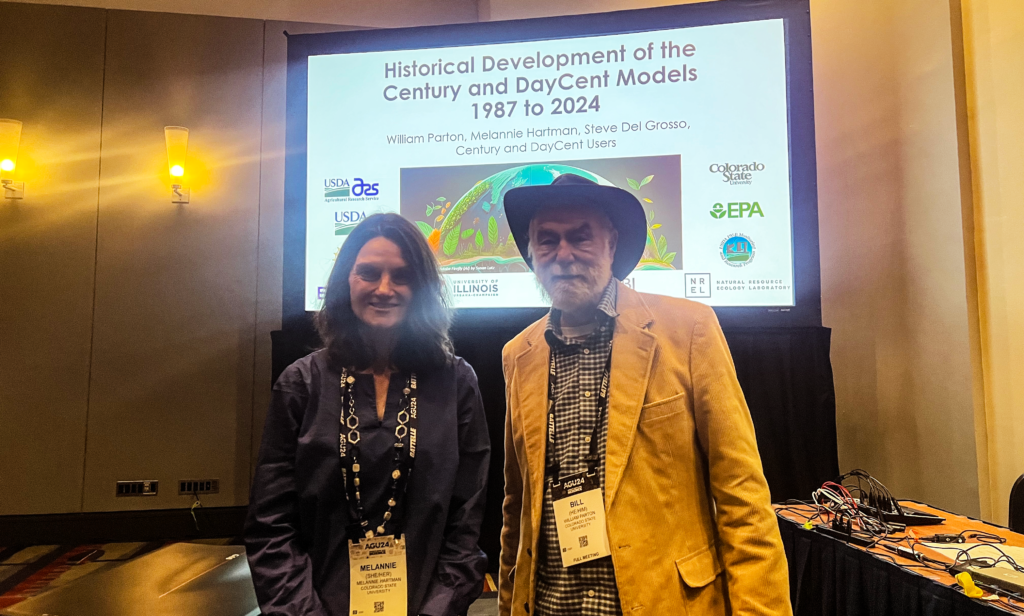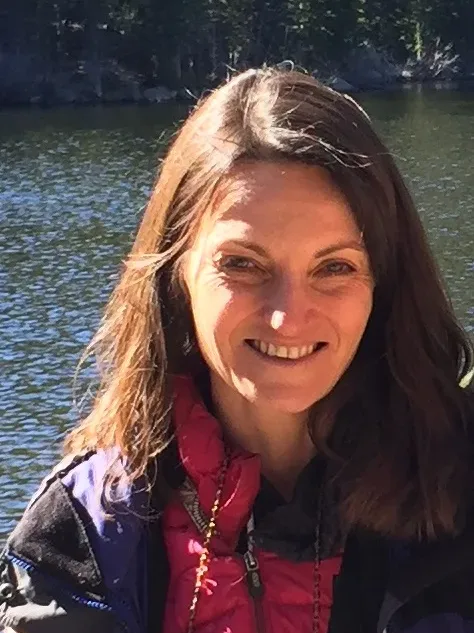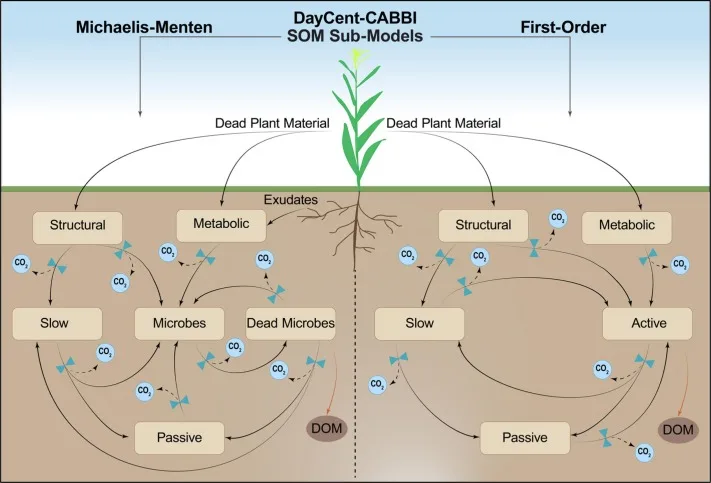
As the planet warms, “carbon sequestration” has emerged as a frequent buzzword in the climate change lexicon. The concept of reducing the amount of carbon dioxide in the atmosphere by sequestering it in plants and soils holds promise, especially since ecosystems have been doing it for millennia.
That process lies at the core of bioenergy and the mission of the Center for Advanced Bioenergy and Bioproducts Innovation (CABBI). By using renewable plant biomass as a source for energy, the CO2 emitted from the combustion of biofuels finds its way back into the crops by the next season’s plantings and, under the right conditions, into the surrounding soil. It’s a closed, carbon-neutral loop.
All of which would have been news 40 years ago to a young South Dakota School of Mines computer science student named Melannie Hartman, now a Senior Research Associate at Colorado State University and Co-PI at CABBI, a Department of Energy Bioenergy Research Center (BRC). “I didn’t know back then how I’d end up using my computer programming skills. I also knew very little about the life cycle analysis of biofuels and whether they could be sustainable and have a net greenhouse gas benefit,” Hartman said.
Today, Hartman is still investigating life cycle analysis. Most of her CABBI research is focused on the viability of feedstocks — primarily the perennial crops miscanthus and switchgrass — as bioenergy sources and, perhaps, natural climate solutions (NCS). CABBI researchers focus on miscanthus, sorghum, and sugarcane but also collaborate with other BRCs on switchgrass.

When Hartman first became interested in science, the term “NCS” would not be coined for another 30-odd years and bioenergy research was in its infancy. The climate was also cooler by 1.25 degrees Celsius — perfect weather for a field trip.
“In high school, I had teacher named Mr. Leget. He led field trips to Rocky Mountain National Park for us Ohio kids, which was a big deal for me,” Hartman said. “He fueled my interest in science and chemistry and Earth science.”
Since then, Hartman’s passion for science stayed true, though her specific interests have changed along with those of the scientific community. When Hartman took those field trips, fewer than 50 miles from where she would later make her career at Colorado State, miscanthus was virtually unknown in America and switchgrass had been populating the prairie for millennia.
Those two grasses provide a host of benefits that the United States’ main source of bioenergy, corn — a third of which is used for ethanol — lacks. Maize requires a lot of fertilizer and is sensitive to temperature and precipitation swings, making it susceptible to the whims of an increasingly unpredictable climate. It also has what some might call biomass issues: “Corn is a pretty big plant,” Hartman said, “but miscanthus is even bigger.”
However, miscanthus, switchgrass, and other bioenergy crops are still mostly unknown quantities compared to corn, which has been grown and tested by generations of farmers. In a changing climate, scientists haven’t had generations to observe these grasses in midwestern soils, predict their greenhouse gas-trapping properties, and therefore viability as NCSs. That is a task fit for ecosystem models like DayCent-CABBI.
The Daily Century biogeochemical computer model, or DayCent for short, predates CABBI by more than two decades. Using concepts from the monthly Century model previously developed at Colorado State University, DayCent was designed by Hartman and her colleague, Professor Bill Parton, as a model that can simulate forest, grassland, and agricultural ecosystems at a timestep that is important for accurately predicting greenhouse gas emissions.
“It was just a general ecosystem model, something that can simulate the plant and soil processes at an ecosystem level,” Hartman said. “We wanted to look at the exchange of carbon and nitrogen in between the plants and soil.” When Hartman and Parton joined CABBI as inaugural members in 2017, they got to work on a new version, aptly named DayCent-CABBI. This new expansion of the original DayCent model was tailored especially for bioenergy crops.
“Before DayCent-CABBI, the model could simulate trees, which had branches, large wood, and coarse roots. And it could simulate grasses and crops, but these plants had just one mass of aboveground biomass and one mass of roots,” Hartman said. “For DayCent-CABBI, we thought, ‘Well, when representing a large crop, it should be a cross between a grass and a tree; something that’s really tall with stems, leaves, rhizomes and roots.’”
To understand exactly how DayCent-CABBI replicates the precise complexity of a crop-soil ecosystem — and then attempts to make an estimation on its sustainability — requires a quick lesson in crop science.
Put simply, after a plant has spent its life breathing in carbon dioxide, all of that CO2 ends up stored in its biomass. When the plant dies, any dead plant material that wasn’t harvested — stems, leaves, roots, etc. — is incorporated into the soil, where it’s eventually broken down, with some being stored away in the soil and the rest emitted back as CO2 into the atmosphere as a product of microbial respiration.
Agricultural ecosystems, though, are complex mechanisms. Many factors can throw wrenches into the machine, including miscanthus’s deep roots, crop management practices that affect the way soil microbes break down plant material, changing climatic conditions, and the generation of other greenhouse gases. Hartman has been researching how to incorporate these factors into updated versions of and new applications for DayCent-CABBI, including the addition of a new soil organic module that represents soil formation deep in the ground.
In a 2022 paper published in Ecosphere, Hartman used DayCent-CABBI to evaluate how best to suppress plant nitrification in sorghum grown in rotation with soybean crops.
“Nitrification is the conversion of ammonium to nitrate,” Hartman said. “Ammonium is a source of nitrogen that plants use to build their tissues. Nitrate, on the other hand, is much more mobile. If plants don’t consume it, it leaches out of the soil. It can pollute streams.” These effects are often amplified because many bioenergy crops, including corn and sorghum, are treated with nitrogen-based fertilizers.

Hartman notes that nitrification not only affects surrounding land and water, but the atmosphere as well. The process of nitrification emits nitrous oxide (N2O), very potent greenhouse gas. “We want to avoid N2O emissions as much as possible and agricultural systems are big emitters,” Hartman said.
Thankfully, sorghum roots are home to nitrification-inhibiting compounds. These data were all accounted for in the DayCent-CABBI model, and Hartman and her colleagues launched a modeling study to evaluate the effectiveness of these compounds.
“What we found is that when we applied the model at the ecosystem level over the whole growing season, the timing of when the roots release these compounds did not coincide with the timing of when nitrification happens in the soil at an ecosystem level,” Hartman said. “So it was all about timing. The roots were suppressing nitrification too late in the growing season to have much benefit at the ecosystem level. But that was what the model predicted.”
For that particular study, DayCent-CABBI unfortunately predicted that sorghum nitrification suppression would not lead to reduced greenhouse gas emissions. Nevertheless, this modeling exercise inspired new field experiments to address the timing issue. Combining modeling with field-based measurements opens the door for more research to be conducted, expediting CABBI’s mission to accelerate the transition to a bioeconomy.
That transition will undoubtedly encounter hurdles — ones not confined to nitrification or even crop science. Miscanthus, despite being a more climate-resilient bioenergy crop than corn, is not native to the United States, making it unfamiliar to ecosystems and farmers alike.
“If we ever want what we’re studying as scientists to be implemented in the real world, we have to get farmers on board to grow the crops that we say are the most environmentally sustainable,” Hartman said. “There might be a farmer who has been growing corn for a long time and is afraid to switch to growing miscanthus because they’re not familiar with it. Miscanthus also takes a couple of years to get established before it can be harvested and become profitable. Asking farmers to switch crops that they’ve been growing and selling for a long time is a stumbling block.”
Until that happens, researchers within CABBI, and even around the world, are using and modifying DayCent to better understand the planet’s ecosystems. Hartman and Parton recently received an invention disclosure for DayCent-CABBI. “It has been quite fulfilling to have joined forces with Bill to develop this model that has become so useful for studying agroecosystems,” Hartman said.
“When I first started working on the DayCent model with him, I wasn’t a big thinker,” she said. “I was just working on the details of the model and thinking, ‘Oh, this is going to be a model that Bill and I, and few other people, will use for research.’ But Bill was a big thinker and at some point, I thought, ‘Wow, DayCent’s being used all over the world and Bill and I were the ones who first developed it.’ I still can’t totally grasp that.”
— Article by CABBI Communications Associate Gabe Lareau